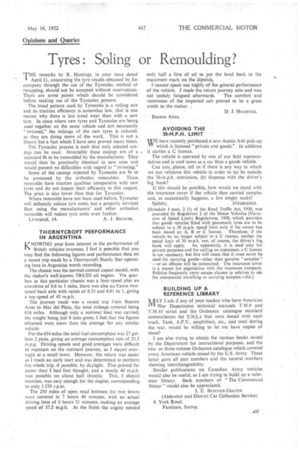Tyres: Soling or Remoulding?
Page 53

If you've noticed an error in this article please click here to report it so we can fix it.
JHE remarks by R. Hastings, in your issue dated
April 11, concerning the tyre results obtained by his company through the use of the Tyresoles method of recapping, should not be accepted without reservations. There are some points which should be considered before making use of the Tyresoles process.
The tread pattern used, by Tyresoles is a rolling one and its traction efficiency is somewhat low, that is one reason why there is less tread wear than with a new tyre. In cases where new tyres and Tyresoles are being used together on the same vehicle and not necessarily "twinned," the mileage of the new tyres is reduced, as they are doing more of the work. This is not a theory but a fact which I have seen proved many times.
The Tyresoles process is such that only selected casings can be used. Invariably these casings are of a standard fit to be remoulded by the manufacturer. They would then be practically identical to new ones and would present no difficulties with regard to "twinning."
Some of the casings rejected by Tyresoles are fit to be processed by the orthodox remoulder. These remoulds have traction qualities comparable with new tyres and do not impair their efficiency in this respect. The price is also lower than that for Tyresoles.
Where remoulds have not been used before, Tyresoles will definitely reduce tyre costs, but a properly serviced fleet using the manufacturers' and other orthodox remoulds will reduce tyre costs even further.
Liverpool, 14. A. J. BROWNE.
THORNYCROFT PERFORMANCE IN. ARGENTINA VNOWING your keen interest in the performance of 116 British vehicles overseas, I feel it possible that you may find the following figures and performance data on a recent trip made by a Thornycroft Sturdy Star operating here in Argentina worth recording.
The chassis was the normal-control export model, with the maker's well-known TR6/DI oil engine. The gearbox in this particular chassis was a four-speed plus an overdrive of 0.8 to I ratio, there was also an Eaton twospeed back axle with ratios of 6.33 and 8.81 to 1, giving a top speed of 45 m.p.h.
The journey made was a round trip from Buenos Aires to Mar del Plata, the total mileage covered being 634 miles. Although only a nominal load was carried; the weight being just 8 tons gross, I feel that the figures obtained were more than the average for any similar vehicle.
For the 634 miles the total fuel consumption was 27 gallons 2 pints, giving an average consumption rate of 23.5 m.p.g. Driving speeds and good averages were difficult to maintain on the outward journey, as I stayed overnight at a small town. However, the return was easier as I made an early start and was determined to perform the whole trip, if possible, by daylight. This proved far easier than I had first thought, and a steady 40 m.p.h. was possible on about half throttle. This, I should mention, was easy enough for the engine, corresponding to Only 1,550 r.p.m. • The 250 miles of open road between the two towns were covered in 7 hours 40 minutes, with an actual driving time of 6 hours 31 minutes, making an average speed of 37.5 m.p.h. At the finish the engine needed only half a litre of oil to put the level back to the maximum mark on the dipstick cannot speak too highly of the general performance of the vehicle. I made the return journey solo and was not unduly fatigued afterwards. The comfort and roominess of the imported cab proved to be a great credit to the maker.
D. J. HEMSTED.




















































































